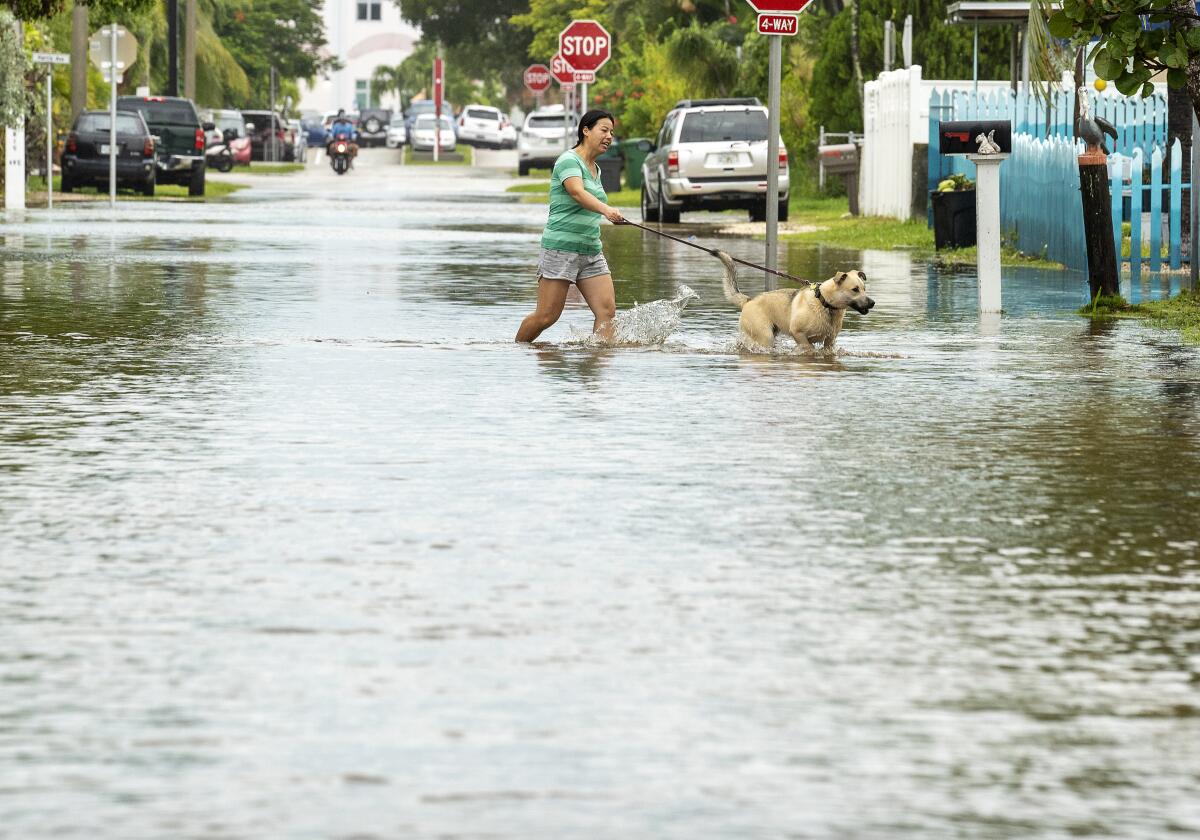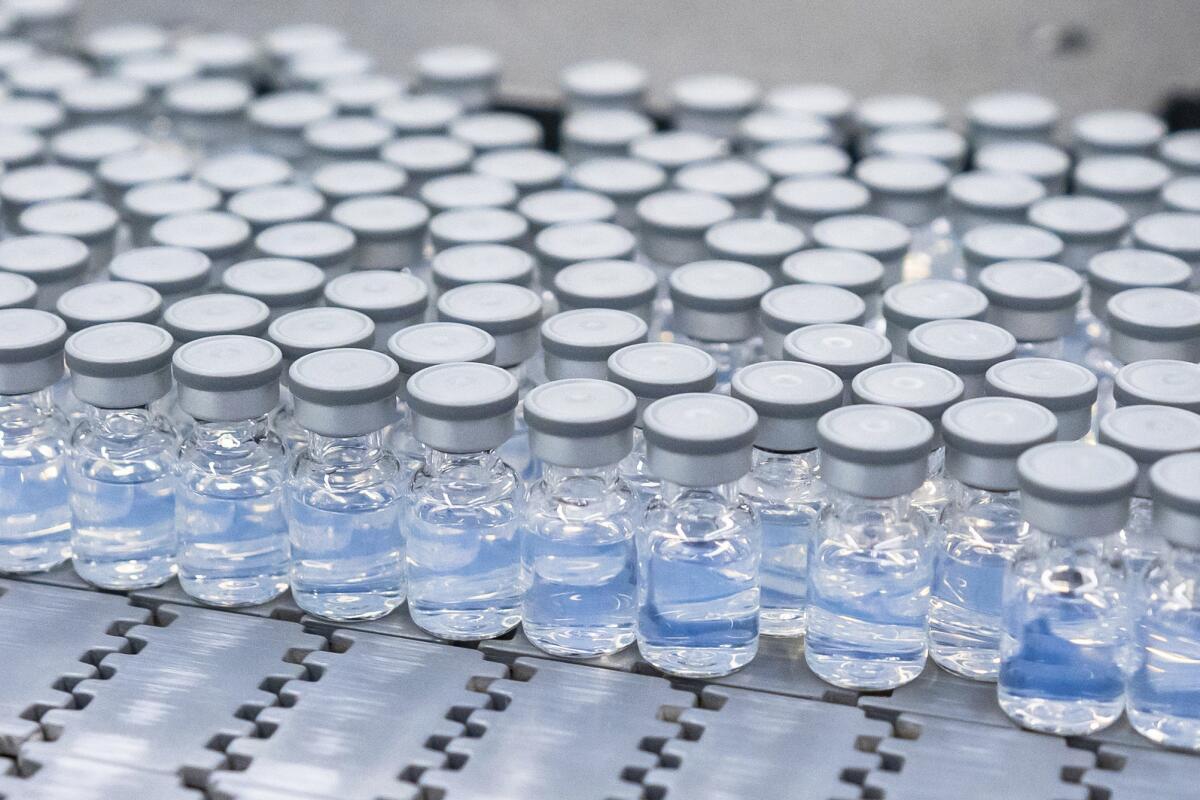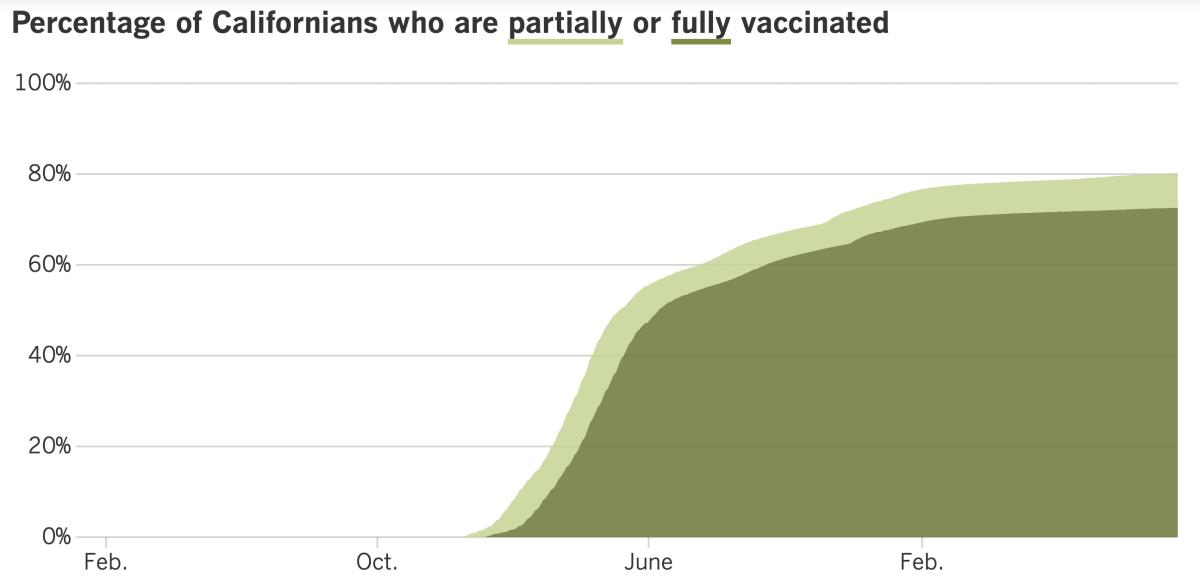Coronavirus Today: What COVID-19 and Hurricane Ian have in common
- Share via
Good evening. I’m Karen Kaplan, and it’s Tuesday, Oct. 18. Here’s the latest on what’s happening with the coronavirus in California and beyond.
There are things in life we can control and things we can’t. Disasters we can see coming and disasters that blindside us. Even when a calamity is headed our way, it can be hard to tell whether we’re in for a direct hit or if it will skirt by harmlessly.
Waves of COVID-19 are like this. Entire pandemics are like this. So are natural disasters like Hurricane Ian.
The Category 4 storm struck Florida three weeks ago before moving on to the Carolinas and Virginia in a weakened but still destructive state. It was the third-deadliest storm to hit the mainland United States this century, killing more than 100 people over four days.
Dr. Mark Morocco narrowly escaped Ian’s wrath. The UCLA emergency medicine physician lives part time in Key West. That’s where he was when the hurricane spun toward the Florida Keys. He was lucky to get out before the airport shut down.
“It turns out being stalked by a hurricane feels just like the eve of the pandemic, when we knew a storm was coming but little else,” Morocco writes in an op-ed for the L.A. Times. “Both are slow-moving disasters at the beginning. Both can cause great death and injury, or not.”

Ian arrived with a burst of drama and then was gone. COVID-19 is still with us. Even in its current, relatively quiet state, the disease kills nearly three times as many Americans in a single day as Ian did over its short lifetime. Yet 2½ years into the pandemic, it often feels like those deaths barely register anymore.
“There is a ton of denial in our society — COVID, climate change, outcomes of political elections,” Morocco writes. “We humans have a decent ability to psychologically shrug unless something happens directly to us or those we love. If not, we feel momentarily sad and then move on.”
It sounds heartless, but as a coping mechanism, it has its upsides. Morocco says there’s no other way he could survive as an ER doctor.
Here’s another thing Hurricane Ian and COVID-19 have in common: Both have challenged our hubris.
“Ian has humbled Florida,” Morocco writes, just as “we doctors were humbled by the pandemic.”
He doesn’t pull his punches when it comes to his own profession.
“We fumbled communicating what we knew and did not know, giving the crazy theories and outright lies a chance to dominate and dilute good advice,” he writes. “People died because of it.”
And they’re still dying, which means doctors can’t give up yet. Neither can the rest of us.
“Thirty percent of Americans remain unvaccinated, our life expectancy is down, and COVID is the third-leading cause of death in the U.S.,” Morocco writes. “Like Ian, it doesn’t care what our politics are or what state we are fleeing from. COVID is happy to mutate freely while we argue.”
[Read some related advice from our sister newsletter Group Therapy: “Chronic stress and the pandemic: What you can do.”]
By the numbers
California cases and deaths as of 2:30 p.m. Tuesday:

Track California’s coronavirus spread and vaccination efforts — including the latest numbers and how they break down — with our graphics.
A booster that needs a boost
Some things just go together, like peanut butter and chocolate, Kobe Bryant and Shaquille O’Neal, or Rocky and Bullwinkle.
The coronavirus and winter do not belong on that list. The first pandemic winter brought with it the deadliest days of the outbreak, with the U.S. experiencing as many as 4,000 COVID-19 fatalities per day. The second winter shattered all caseload records, with up to 812,000 official infections reported each day.
Anyone want to guess what this winter has in store?
After two surges fueled by distinct Omicron subvariants, things look pretty calm. Health officials would really like to keep it that way, and they say the new COVID-19 boosters are our best bet for doing so. Not only will the shots recharge our immunity, but they’re also expected to do a better job of fending off the BA.5 and BA.4 strains, which together account for more than two-thirds of the coronavirus specimens circulating throughout the country.
The bivalent boosters became available last month, and the Biden administration has pledged to deliver at least 170 million doses to Americans at no cost to them. But officials are running into the same problem that has plagued the entire vaccination campaign: lackluster demand.
As of Tuesday, the Centers for Disease Control and Prevention says 9,523,294 doses of Pfizer’s bivalent vaccine and 5,254,470 doses of Moderna’s updated shot have been administered in the U.S. Those may look like big numbers, but they add up to fewer than 5% of all Americans.
“America is not rushing out to get the new booster,” said Drew Altman, president and chief executive of the Kaiser Family Foundation.

To be eligible for one of the new boosters, you have to be at least 5 years old and be fully vaccinated. Only 72% of Americans meet those criteria, according to the CDC. So even if everyone eligible for the new booster were to suddenly get it, 28% of us would still be unprotected.
What gives? Why isn’t there more interest in what White House COVID-19 coordinator Dr. Ashish Jha called a “really important” shot?
For starters, many Americans don’t even know it exists. The latest edition of the KFF COVID-19 Vaccine Monitor poll found that 20% of those surveyed had heard “nothing at all” about the updated boosters, and an additional 31% had heard just “a little.”
It’s not as though this poll happened in July, when the shots were still being reformulated and Americans were busy thinking about summer vacations. This survey was conducted between Sept. 15 and 26, when the shot was already available. (It was also well after CDC Director Dr. Rochelle Walensky pledged to step up the agency’s coronavirus-fighting game.)
Some people who were aware of the new boosters didn’t know whether the shots were meant for them. Fully 40% of those surveyed by KFF who were indeed booster-eligible said they were unclear on that key point, and an additional 11% mistakenly said the CDC had not recommended the booster for people like them.
Of the more than 1,500 people surveyed, 12% were fully vaccinated and able to get the new shot but told KFF they “definitely” wouldn’t do so. An additional 10% said they’d get it “only if required,” and 18% said they’d have to “wait and see” before making up their minds.
Only 5% said they’d already gotten the bivalent booster, and 27% said they planned to do so “as soon as possible.” The remaining 27% weren’t eligible for the booster because they weren’t fully vaccinated.
The Food and Drug Administration requested the updated booster, the vaccine makers delivered it, the CDC endorsed it, and the White House praised it. But if they expect the shots to do their job, they’ve still got some work to do.
California’s vaccination progress


See the latest on California’s vaccination progress with our tracker.
Your support helps us deliver the news that matters most.
In other news ...
What happens in Europe usually happens in the United States a month or so later, and what’s happening in Europe now is not exactly heartening.
The director of the European Centre for Disease Prevention and Control, the World Health Organization’s regional director for Europe and the European commissioner for health and food safety warned last week that a new wave of coronavirus infections had begun.
Cases rose by 12% in Germany, 4% in France and 30% in Italy during the first full week of October, according to the latest update from the World Health Organization. Those increases were noteworthy because they bucked the overall trend — worldwide, the number of new cases fell by 10% in the same period. (The global death toll was just about even with the prior week, at around 9,000.)
Germany’s health minister, Karl Lauterbach, called on regional authorities to reinstate indoor mask mandates to stanch the rise in new cases. “The direction we’re going in isn’t a good one,” he said.
Masks are still required in medical and care facilities and on public transportation. Adding more venues to the list won’t be popular, Lauterbach acknowledged last week, but it could head off the need for stronger measures later. “The sooner we step on the brake, the better it will be,” he said.
Europe may be nearly 6,000 miles away, but it’s not too far for Los Angeles County Public Health Director Barbara Ferrer to care about.
“Throughout the pandemic, trends and cases in Europe have served as a predictor for trending cases in the United States,” she said late last week. “This was true at the beginning of the pandemic in March of 2020, and also before each of our subsequent surges. And we should be prepared for it to possibly be true again.”
Gov. Gavin Newsom is planning for something quite different — the end of California’s COVID-19 state of emergency early next year.
Since going into effect on March 4, 2020, the state of emergency allowed Newsom to issue more than 70 executive orders related to vaccinations, testing, evictions, and the way healthcare is practiced in the state, among other things. Many of those executive orders have been terminated over time, and the governor said he could envision the day in the not-too-distant future when they wouldn’t be necessary to deal with the coronavirus.
“We wouldn’t have gotten to this point without” the state of emergency, Newsom said Monday. Now, “with the operational preparedness that we’ve built up and the measures that we’ll continue to employ moving forward, California is ready to phase out this tool.”
He said he was targeting an end date of Feb. 28. That will preserve the flexibility to respond to a third winter surge if it materializes. It will also allow time to pass laws to let nurses keep dispensing COVID-19 therapeutics and allow lab workers to keep focusing solely on processing coronavirus tests even after the state of emergency ends.
The Biden administration, meanwhile, said last week it would extend the federal public health emergency through Jan. 11.
The federal emergency was first declared in January 2020, and it’s been renewed every 90 days since. It allows the FDA to expedite the authorization of new vaccines and drugs for emergency use, lets the government make those vaccines and drugs available to the public for free, and plenty of other things you may have come to take for granted.
Speaking of emergency use authorizations, the FDA granted some last week for bivalent booster shots for elementary-school-age children. The reformulated shot from Moderna is now available for children as young as 6, and the version from Pfizer and BioNTech can be given to children as young as 5.
Like the updated boosters for Americans 12 and up, these shots target the Omicron subvariants BA.5 and BA.4 as well as the original coronavirus strain. As with adolescents and adults, younger children are eligible for the booster if they completed their primary COVID-19 vaccination series at least two months ago.
Fewer than half of L.A. County’s younger children meet those criteria, according to Ferrer. “Out of the nearly 900,000 children in L.A. County that are ages 5 to 11,” she said, “there are over 500,000 children that have not yet received their primary series.”
The new Moderna boosters are already available in L.A. County, and the Pfizer-BioNTech ones are expected to join them as soon as Wednesday. Parents can visit VaccinateLACounty.com to find a location to get a shot.
Elsewhere in the state, parents can search for an appointment using MyTurn.ca.gov or by calling (833) 422-4255.
Preliminary data from Pfizer and BioNTech suggest their new booster is working as intended. A study of blood drawn from 80 people a week after they received the shot found that they had elevated levels of antibodies to the BA.5 and BA.4 subvariants, as expected. Those levels were higher than in the blood of people who were boosted with the original version of the shot.
The study will continue, but the initial results are encouraging, said Pfizer Chief Executive Albert Bourla. “These early data suggest that our bivalent vaccine is anticipated to provide better protection against currently circulating variants than the original vaccine, and potentially help to curb future surges in cases this winter,” he said.
And finally, Indonesia unveiled its first home-grown COVID-19 vaccine last week, a move intended to make the world’s fourth-most-populous country less dependent on imported shots.
The IndoVac vaccine has been in development since November 2021, in collaboration with scientists at Baylor College of Medicine in Houston. The shots were authorized by Indonesia’s Food and Drug Administration and signed off by the country’s highest Islamic body, which declared them fit for use by Muslims. That’s a key endorsement because Indonesia is home to nearly 13% of the world’s Muslims, more than any other country.
The IndoVac shots will be available as a primary series and as boosters, for both adults and children.
Your questions answered
Today’s question comes from readers who want to know: Is it possible to have too many coronavirus antibodies?
There are a lot of things to worry about when it comes to COVID-19. Thankfully, this is not one of them.
Your immune system produces coronavirus antibodies in response to either a real infection or a dose of COVID-19 vaccine (which tricks your body into thinking it’s been infected). The antibodies latch on to viral invaders and neutralize them so they can’t enter your cells and wreak all kinds of havoc.
The amount of antibodies your immune system makes depends on many factors. For instance, someone with a severe case of COVID-19 will produce more antibodies than someone with a mild infection. Likewise, a younger person with a stronger immune response will produce more antibodies than an older person with a weaker immune response.
But no matter what, there is an upper limit, according to Dr. Otto Yang, an infectious-disease specialist at UCLA.
“The body has a natural ceiling for how much antibody can be produced,” Yang said, “so it’s not possible to make ‘too much.’”
Yang led a study last year that tracked antibody levels in people after they’d become infected or been vaccinated. People who’d never had COVID-19 needed both doses from their primary vaccination series to achieve their peak level of antibodies. However, people who’d already recovered from COVID-19 reached their peak after their first dose — their levels didn’t climb higher after Dose 2.
The research team also found that the more antibodies a person had at the time of vaccination, the fewer antibodies they gained from the shot. That inverse relationship suggests “that levels were constrained by a biological ceiling,” the researchers wrote in the journal ACS Nano.
We want to hear from you. Email us your coronavirus questions, and we’ll do our best to answer them. Wondering if your question’s already been answered? Check out our archive here.
The pandemic in pictures

These are some of the 5,000 steel leaves that made up an art installation at Westminster Abbey in London. Each leaf was inscribed with the same word: hope.
“The Leaves of the Trees,” by sculptor Peter Walker, was meant to evoke fallen autumn leaves. It was part of a remembrance service held at the abbey last week to honor those who had died of COVID-19, as well as those in the National Health Service and elsewhere who served the country over the last 2½ years.
“This is a moment of complex feelings,” the dean of Westminster, David Hoyle, said during the service. “We measure the loss of over 200,000 lives, each one precious and particular.... Yet we also gather to give thanks for the courage, skill and selflessness of so many different people who put the needs of others before their safety and before their comfort.”
The steel sycamore leaves, which were placed around the grave of the Unknown Warrior, were joined by actual leaves on saplings that will be planted in a Trees of Life glade at the National Memorial Arboretum in Staffordshire. The saplings received blessings from Hoyle and representatives of 10 faith communities.
“Let us pray that these saplings may grow into a living memorial of those who served and died in the COVID-19 pandemic,” Hoyle said.

Resources
Need a vaccine? Here’s where to go: City of Los Angeles | Los Angeles County | Kern County | Orange County | Riverside County | San Bernardino County | San Diego County | San Luis Obispo County | Santa Barbara County | Ventura County
Practice social distancing using these tips, and wear a mask or two.
Watch for symptoms such as fever, cough, shortness of breath, chills, shaking with chills, muscle pain, headache, sore throat and loss of taste or smell. Here’s what to look for and when.
Need to get a test? Testing in California is free, and you can find a site online or call (833) 422-4255.
Americans are hurting in various ways. We have advice for helping kids cope, as well as resources for people experiencing domestic abuse.
We’ve answered hundreds of readers’ questions. Explore them in our archive here.
For our most up-to-date coverage, visit our homepage and our Health section, get our breaking news alerts, and follow us on Twitter and Instagram.




